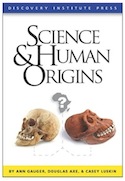 Evolution
Evolution
 Human Origins
Human Origins
Human Origins and the Fossil Record: What Does the Evidence Say?
 Human Origins and the Fossil Record: A Recap Human Origins and the Fossil Record: A Recap— Read the Book: Science and Human Origins — • This Post (Part 1): Human Origins and the Fossil Record: What Does the Evidence Say? |
 Our new book from Discovery Institute Press, Science and Human Origins, co-authored by Douglas Axe, Ann Gauger, and myself, covers both the genetic and fossil evidence as it relates to the origin of humans. One of my chapters is titled “Human Origins and the Fossil Record,” and it assesses the fossil evidence regarding the alleged evolution of humans from lower hominins. In 2005, I published an article in the journal Progress in Complexity, Information, and Design on the same topic titled “Human Origins and Intelligent Design: Review and Analysis.”
Our new book from Discovery Institute Press, Science and Human Origins, co-authored by Douglas Axe, Ann Gauger, and myself, covers both the genetic and fossil evidence as it relates to the origin of humans. One of my chapters is titled “Human Origins and the Fossil Record,” and it assesses the fossil evidence regarding the alleged evolution of humans from lower hominins. In 2005, I published an article in the journal Progress in Complexity, Information, and Design on the same topic titled “Human Origins and Intelligent Design: Review and Analysis.”
However, the field of paleoanthropology is constantly changing, and multiple new fossils have been reported in the intervening years. Science and Human Origins provided an opportunity to update the arguments, which I would like to review now here at ENV.
Evolutionary scientists commonly tell the public that the fossil evidence for the Darwinian evolution of humans from ape-like creatures is incontrovertible. For example, anthropology professor Ronald Wetherington testified before the Texas State Board of Education in 2009 that human evolution has “arguably the most complete sequence of fossil succession of any mammal in the world. No gaps. No lack of transitional fossils… So when people talk about the lack of transitional fossils or gaps in the fossil record, it absolutely is not true. And it is not true specifically for our own species.”1 According to Wetherington, the field of human origins provides “a nice clean example of what Darwin thought was a gradualistic evolutionary change.”2
Digging into the technical literature, however, reveals a story starkly different from the one presented by Dr. Wetherington and other evolutionists engaging in public debates.
As my chapter shows, the fossil evidence for human evolution remains fragmentary, hard to decipher, and hotly debated. Those willing to look at the evidence with a critical, skeptical eye are hardly required to accept the grand story of human evolution from lower primates.
Indeed, far from supplying “a nice clean example” of “gradualistic evolutionary change,” the record reveals a dramatic discontinuity between ape-like and human-like fossils. Human-like fossils appear abruptly in the record, without clear evolutionary precursors, making the case for human evolution based on fossils highly speculative.
My thesis can be summarized as follows:Hominin fossils generally fall into one of two groups: ape-like species and human-like species, with a large, unbridged gap between them. Despite the hype promoted by many evolutionary paleoanthropologists, the fragmented hominin fossil record does not document the evolution of humans from ape-like precursors.
I’ll be discussing this issue more in the coming weeks.
References Cited:
(1) Ronald Wetherington testimony before Texas State Board of Education (January 21, 2009). Original recording on file with author, SBOECommt-FullJan2109B5.mp3, Time Index 1:52:00-1:52:44. Click here for the relevant audio.
(2) Ibid.
